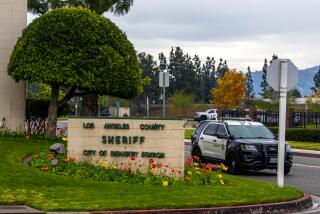One director’s take on the latest digital camera
- Share via
Director Robert Rodriguez has always had one eye on the bottom line. His 1995 book, “Rebel Without a Crew,” explained how he was able to shoot his debut feature, “El Mariachi,” as quickly and cheaply ($7,000) as possible. That attitude followed him to Hollywood, where the scope of his projects has increased while he continues to keep his budgets and shooting schedules lean.
So it’s no surprise that Rodriguez hasn’t hesitated to embrace Sony’s new HDWF900 digital motion picture camera. The camera, developed by Sony’s Broadcast and Production Systems Division, resembles a VHS camera in its size and ability to record on videocassette but digitally records film-quality images with considerably less effort than film cameras.
Rodriguez’s move to digital, which he used to shoot his recent features “Spy Kids 2” and “Spy Kids 3-D,” along with his latest, “Once Upon a Time in Mexico,” puts him in a select group of directors, including George Lucas and James Cameron, who have moved, ahead of the industry, to adopt the new technology.
Rodriguez recently met for the first time with the camera’s inventors, Satoshi Yamaga, national product manager for digital cinematography, and Yasuhiko Mikami, national marketing manager for movie and TV applications, to discuss the camera, its long development and its practical applications.
Question: In a way, is this camera trying to combine both a TV camera and motion picture camera into one?
Mikami: Yes, it can be used as an ordinary news-style camera, shooting at 30 frames per second.... . You can also switch it to work at 24 frames per second, like film cameras. This is the very first time we’ve been able to create a camera that can be used in both worlds.
Q: Does this camera almost do the cinematography for you?
Rodriguez: No, you still have to light it. But you can light much more to your eye. To get the shot, you don’t need to bring all this equipment over and use the light meter and think, “Well, if the soup is this temperature tomorrow ....” You don’t have to do all that crazy stuff.
Q: Why did you decide to shoot digitally?
Rodriguez: After “Spy Kids,” I was not doing certain movies simply because of the hassle of shooting on film. It’s like painting with your eyes closed. The next day [after shooting] it gets developed and sent back to you and you get to see if you even got what you were trying to get. A lot of times you don’t. It’s why movies take a long time and cost a lot of money. What digital does is, it frees you up to be able to shoot much faster, to be able to see the image while you’re shooting it. You don’t have to say the traditional “That was great. Let’s just do one more.”
Mikami: I happen to be a film guy as a hobby. Shooting with film, especially black-and-white film, as a hobby is a great thing. It’s so pleasing to your eye. But to people like Robert, who are in the film business, it’s not a hobby. It’s a business, and he wants to be productive; he has certain goals to meet.
Rodriguez: What do you think the difference is between the look of digital and the look of black-and-white film? Do you think you could get that look with digital?
Mikami: If you are looking at large negative [film], it might take some time for digital to beat that. If it’s ordinary 35-millimeter [film], I think we’re getting very, very close. Shooting in film is very much like improvisation, like jazz. Sometimes, if you’re lucky, you get the results right. There aren’t many people in this town who are very good at it. With digital, the average hit rate becomes higher.
Q: Is there still an advantage to shooting film?
Rodriguez: I did a whole comparison, side by side, pros and cons, before doing “Mexico,” and the only reason I could see to shoot on film was nostalgia. If you were to compare the hard cost of shooting on film to shooting on tape, you’d save millions of dollars shooting on tape. I know I never could have shot [this film] with the schedule and budget [$29 million] we had.
Yamaga: From our point of view, if we add one more paintbrush to creative people, that would be wonderful.
Q: Why has it taken so long for picture to follow sound into the digital realm?
Mikami: In the early 1980s, when we had our first-generation, high-definition camera, you needed a truck to carry the recorder and the camera-processing circuits. We were dealing with five times more detail when you compare standard-resolution film to high-definition. It took us nearly 20 years to come over that. Once we did, we were able to pack all that computing power into a hand-held camera.
Q: What’s the advantage of digital filmmaking for the average moviegoer?
Rodriguez: It just looks better. It looks a lot cleaner, and it gives you better colors. People get confused. They look at digital and say, “Yeah, but it doesn’t look as grainy as film does.” That’s like saying, “CDs are great, but they don’t have that snap, crackle and pop like my old vinyl records.” That’s the medium, that’s not the music. You’re so used to it, it doesn’t mean it’s wrong when it’s gone. [Digital] is even better for movies without effects -- run-and-gun or personal movies -- because of how it treats the actor. You’re moving at the speed of creative thought.
More to Read
Only good movies
Get the Indie Focus newsletter, Mark Olsen's weekly guide to the world of cinema.
You may occasionally receive promotional content from the Los Angeles Times.










